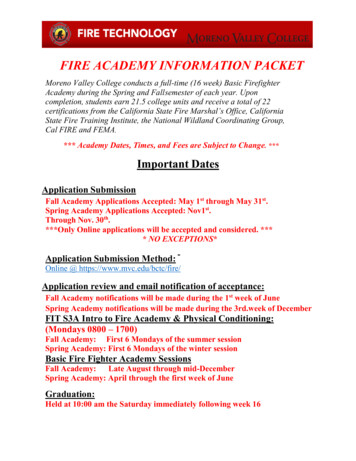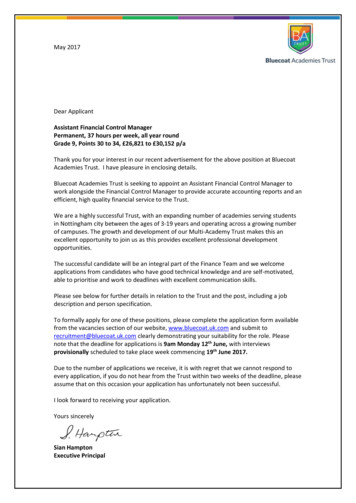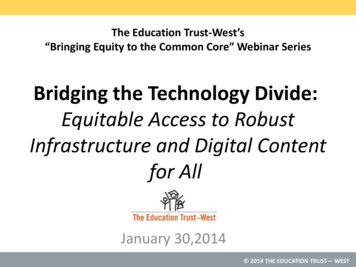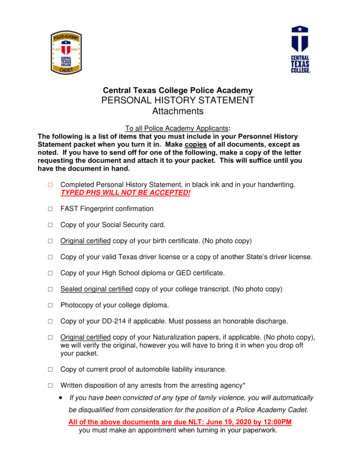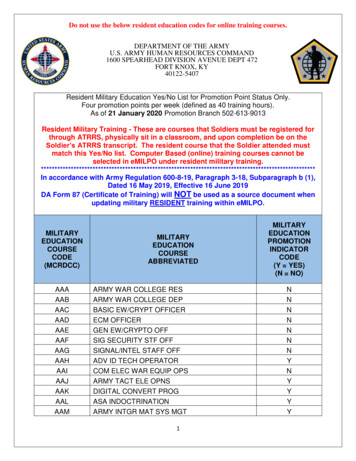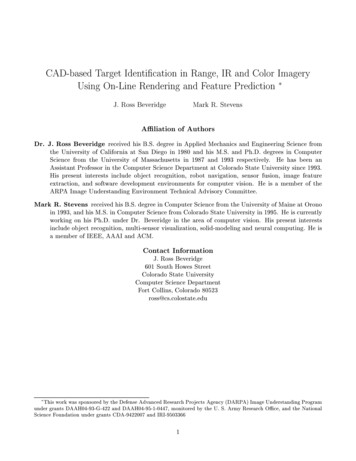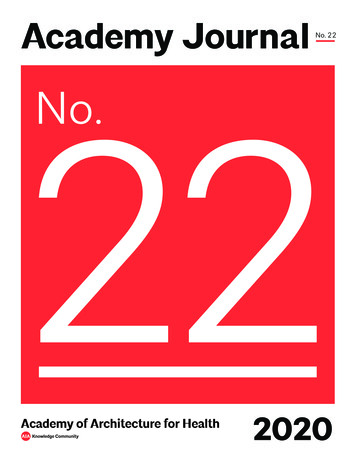
Transcription
Academy JournalNo. 2 22020
Mission of the Academy JournalAs the official journal of the AIA Academy of Architecturefor Health (AAH), this publication explores subjects ofinterest to AAH members and others involved in thefields of health care architecture, planning, design,and construction. The goal is to promote awareness,educational exchange, and advancement of the overallproject delivery process, building products, and medicalprogress that affect all involved in those fields.About AAHAAH is one of 21 member communities of The AmericanInstitute of Architects (AIA). AAH is unique in the depthof its collaboration with professionals from all sectorsof the health care community, including physicians,nurses, hospital administrators, facility planners,engineers, managers, health care educators, industryand government representatives, product manufacturers,health care contractors, specialty subcontractors, allieddesign professionals, and health care consultants.AAH currently consists of approximately 7,000 members.Its mission is to provide knowledge which supports thedesign of healthy environments by creating educationand networking opportunities for members of – and thosetouched by – the healthcare architectural profession.Please visit our website at aia.org/aah for more about ouractivities. Please direct any inquiries to aah@aia.org.Academy Journal editorRegan Henry, RA, PhD, LEED AP, LSSBBContentsAAH 2020 board of directorsPresident/OutreachKirsten Waltz, AIA, ACHA, EDAC, LEED APPast president/OperationsTushar Gupta, FAIA, NCARB2021 President/StrategyBrenna Costello, AIA, ACHA, EDACCodes and standardsMichelle L. Trott, AIA, NCARB, ACHACommunicationsTodd Robinson, AIA, EDACConferencesOmri Kenneth Webb IV AIA, ACHAEducationEllen Taylor, PhD, AIA, EDACVisibilitySouthern Ellis, AIA, LEED AP3Letter from the editor4Telehealth and the changingshape of health spaces12Tailored lighting intervention to promote entrainmentin myeloma transplant patients—A field study24Eliminating hot water handwashing: Five reasons to act30Urban interventions to mitigate the adverse effectsof occupational stress in office buildings42Using choice-based design to improve health51Call for papersACADEMY OF ARCHITECTURE FOR HEALTH 1
About the journalLetter from the editorAs we start the 23rd year of the Academy Journal, published by the AAH Knowledge Community, thisedition includes articles that support the enhancement of the built environment for health care.As the official publication of the Academy, the Journal publishes articles of particular interest to AIAmembers and the public involved in the fields of health care architecture, planning, design, research,and construction. The goal has always been to expand and promote awareness, educational exchange,and advancement of the overall project delivery process, building products, and medical progress thataffects all involved in those fields.2020 has been a difficult year.Articles are submitted to, and reviewed by, an experienced, nationally diverse editorial reviewcommittee (ERC) of medical and architectural professionals. Over the years, the committee hasreviewed hundreds of submissions, responded to writers’ inquiries, and encouraged and assistedwriters in achieving publication. In its over 20-year history, the Journal has provided valuableopportunities for new and seasoned authors from the architecture and health care professions,including architects, physicians, nurses, other health care providers, academics, research scientists,and students from the US and foreign countries.Published articles have explored a broad range of medical topics, including research trends, the futureof health care architecture, cardiac care, future and evolving technology, patient rooms and patientsafety, lighting design for health care, psychology, workplace design, cancer care environments,emergency care, women’s and children’s care, and various health care project delivery methods.We encourage graduates who have received health care research scholarships and others involvedwith research within the health care architecture field to submit their research to the Journal forpublication consideration. We will continue to develop a cross-referenced article index and a broaderbase of writers and readers. The deadline for the 2021 call for papers is May 27, 2021.The COVID-19 global pandemic has impacted our lives in a profound way. Collectively, people havegained a new appreciation for the power of a virus and its potential impact to our hospitals, economy,and social networks. Our friends and colleagues in healthcare have been tested in a manner that will havemeaningful consequences on the industry and what it means to dedicate one’s life to care for another.Many of us have waited on news from scientists, cheered for progress, and followed FDA trials with greatanticipation and awareness for the enormity of the pursuit. Never have I felt so appreciative of the people,networks, supply chains, and infrastructure that support our healthcare system.As this journal goes to print, the dealth toll, in the United States, for COVID-19 stands around 300,000and the first vials of vaccine are being administered to people on the frontline. There is great hope thatwe are at the beginning of the end of this saga, but still reeling from the exposed vulnerabilities to boththe healthcare industry and society at large. We have learned so much and yet there is so much left tounderstand about the last ten months.I look to 2021 and the years to follow as an opportunity to both celebrate our successes and learn fromour missteps so that we are better and more prepared for future generations of frontline workers, patientsin need, and vital equipment suppliers. There is great promise at the juncture between healthcare,design, and research. I applaud Orlando Maione for his vision to foster this journal and thank him forhis many years of leadership and service as The Academy Journal Editor. We close out this year with anappreciation for the work accomplished and excitement for what is to come. I look forward to exploringwith and learning from you in the years to come.Cheers to a happy new year.Since the late 1990s, this free publication has expanded to include worldwide distribution. And we areproud to report that as our readership continues to grow, it also expands internationally. Readers haveviewed the Journal online from the US, Canada, Europe, the Caribbean, Asia, Africa, India, and SaudiArabia, just to name a few. The Journal is available to the 94,000 AIA members and the public on theAIA website at aia.org/aah.Special thanks to AIA for its continued support and hard-working staff and to the many volunteerswho have contributed to our growing and continued success including Doug Paul and SouthernEllis for their leadership on behalf of the AIA and AAH. I would especially like to thank the othermembers of the 2020 ERC: Donald L. Myers, AIA, NCARB; Angela Mazzi, AIA, ACHA, EDAC; SharonWoodworth, FAIA, FACHA; Dale A. Anderson, AIA, NCARB, LEED AP BD C, CSBA, EDAC, MBA,GGP, ACHA; and Erin Mcnamara, EDAC. As always, we appreciate your feedback, comments andsuggestions by emailing aah@aia.org.2 ACADEMY JOURNAL NO. 22Regan Henry, RA, PhD, LEED AP, LSSBBEditor, Academy JournalACADEMY OF ARCHITECTURE FOR HEALTH 3
Telehealth and thechanging shape ofhealth spacesSean Cottengim/GBBN ArchitectsINTRODUCTIONThe quarantine of early 2020 is accelerating changes taking place within the American health care system. Withstay-at-home orders and limits on elective and nonurgent surgeries forcing a much wider-spread adoption oftelehealth practices, now is the time to ask how the rise of telehealth will impact the spaces in which we seekhealth services. And in considering this question, we need to think beyond the clinic. Of course, telehealth willchange the demands that we put on clinical spaces, but they will also see us seeking health services in spaces—spaces we live and work in—that we generally understand to be separate from health care spaces.This article will outline how telehealth specifically demonstrates a basis for speculating about possible futures andexploring the kinds of experiences we should expect to design in our built environments. More specifically, thisarticle intends to illuminate the possible effect of existing and developing technologies on how and where healthcare is delivered, not to prescribe specific design solutions. Designers are responsible for imagining the impact ofsuch developments for the purposes of updating their processes for the benefit of the client and society; this articleseeks to prepare the ground for future design workWhat is telehealth?Telehealth can be defined several ways, but importantlyit allows people to connect with a physician or othercare provider using telecommunication devices thatare common—eliminating the need to attend an inoffice visit. There have been distinctions made betweentelehealth and telemedicine, but for our purposesthe distinction is not important. Using the WorldHealth Organization’s list of “Elements germane totelemedicine,” we can better understand the broad scopeof what telehealth is: Its purpose is to provide clinical support. It is intended to overcome geographical barriers,connecting users who are not in the same physicallocation. It involves the use of various types of informationand communication technologies (ICT). Its goal is to improve health outcomes (World HealthOrganization, 2010).Telehealth refers to a broad range of health services,from simple phone access to health education or sendingmessages to your doctor to more sophisticated practiceslike a face-to-face conversation with your physicianvia a mobile device, which might also involve remotediagnostics monitoring. Some of these options arealready integrated into digital platforms that house apatient’s electronic health records, though the adaptionof this kind of technology is uneven. It is worth notingthat telecommunication technology changing accessto and delivery of health care has existed, rhetorically,4 ACADEMY JOURNAL NO. 22since 1876 when Alexander Graham Bell patented thetelephone and, more realistically, as far back as 1924when Radio News magazine depicted a “radio doctor” onits cover (Field, 1996).Changes in the occurrence of telehealthSeveral leading health systems have shown a significantincrease in telehealth appointments. Many indicatorshave shown an exponential growth of telehealth duringthe quarantine.While only 24% of organizations had an existing virtualcare program by January 2020, reports indicate thattelehealth visits will likely reach 1 billion by the end of theyear (Forrester, 2020). The repercussions of this kind ofgrowth will be with us for years.Cleveland Clinic logged more than 60,000 virtual visitsin March. That’s a 1,700% increase from the previousmonth. And one study found that more than two-thirdsof respondents said the pandemic has increased theirwillingness to try virtual care (Siwicki, 2020).At the end of March, Stanford Medicine reported incrediblegrowth of virtual health. “At 3,000 per day, televisitsnow make up 40% of all clinical visits at Stanford HealthCare, 50 times higher than prior months. The all-timedaily televisit high for Stanford Children’s Health, beforeCOVID-19 hit California, was 35; recently, cliniciansconducted 500 in one day” (Stanford Medicine, 2020).ACADEMY OF ARCHITECTURE FOR HEALTH 5
The disaster dogAI or digital interaction such as disaster relief ordrone-operated assistance or rescue. A practitioner’sexpertise is needed in a situation, but it’s too riskyfor them to be there in person. Think the BostonDynamics robot dog with facetime running on a tableton its head.Willingness to adopt telehealth as a valid form ofinteraction is up as well. Even prior to the events of theCOVID-19 pandemic, the Telehealth Index ConsumerSurvey reports that 66% of Americans were willing touse telehealth. And even seniors are on board, not justtech-savvy millennials (Amwell, 2019). It seems likely thatcomfort with—and patient willingness to adopt—telehealthwill only grow as more and more people gain experiencewith it.The robot buddyIn-home care and monitoring provided by a virtual oran AI assistant. Think Baymax from Big Hero Six (orsimply think health care robot).What might the research suggest?The possibilities for telehealth and its technologicalsuccessors to provide new ways to make connectionsbetween provider and patient raises new questionsabout the future landscape of health spaces. It is worthcategorizing these types of interactions to organize ourthinking on the types of spaces we may begin to include as“health” spaces.The third place—The masseuse, barbershop, gymPeople use these services or interact in theseplaces due to physical aspects of the body. Whilethe primary impetus for using these services is notbuilt around the remote presence of a health careworker, digital technology makes it easy to imaginethese spaces being integrated into a broader healthcare ecosystem. Integration of wellness care atthese locations would not only remove barriers forparticipation in individual health, but could alsoincrease proactive, preventative care by catchingissues before they become a problem “worth going tothe doctor” for.For my purposes, I can set aside the finer points of whatconstitutes telehealth vs. telemedicine. What’s importantis the broader context of how telehealth providescare—or, even more broadly, how can people interact?It is not by coincidence that these types of interactionsare not specific to medical care. This technology hasbeen adopted rather quickly by communication andentertainment industries. Your nephew has probablybeen having digital interactions with his friendsthrough his gaming console for years now. It is themedical sector, however, (and the organizations thatprovide that care) that is currently acknowledgingthese possible modes of interaction and dealing withrules and regulations built for a system that simplydid not accommodate these technologies. A simplecategorization of types of interaction illuminates thespectrum of possibilities for the near and far future.Synchronous physical interaction—Actual attendeeand actual attendeeTwo or more people have a physical interaction in aphysical place; the physicality of place is pertinent to theinteraction. This could be a typical office visit, a surgery,a specialty scan, one-on-one or group therapy in anactual space. Basically, it is any conventional medicalvisit one would be used to. Social interaction typicallyworks best in this way, as well as the efficient transfer ofphysical goods or services (chiropractor) or where thespecialty resources needed have limited mobility or it’snot feasible to provide them in a mobile capacity.6 ACADEMY JOURNAL NO. 22Asynchronous digital interaction—Digital attendeeand digital attendeeTwo or more people meet virtually where their location,appearance, or timing is not important.Ref 1. Helpful terminologySynchronous digital interaction—Actual attendee anddigital attendeeTwo or more people are interacting digitally, but only onephysical space is pertinent to the situation.The virtual house callThe most common current occurrence of a telehealthvisit—virtual, “face-to-face” interaction between theprovider and the patient in real time—allows for adecrease in waiting time and costs; thus, it is moreconvenient in most cases.While patient-provider interaction is between twoparties, it need not be face-to-face or even within thesame space over a period of time (think of passingmessages back and forth over mobile devices). For thatmatter, there may be certain therapies provided thatare enhanced by using an avatar or otherwise makingone’s identity anonymous. An important aspect of thisinteraction type, however, is the privacy of where theuser is accessing the interaction. Think about answeringsensitive questions over the phone for example—theremay be a level of digital or physical privacy necessary(but this could occur with headphones or perhaps a smallprivate area to text or call).Telehealth has the power to be integrated into people’sdaily lives in creative and transformative ways. It maybe obvious that a video call with a doctor is convenient,but the transformative power of care being literallydisconnected from the clinic space can remove many ofthe barriers associated with an individual not pursuingRef 2. The spectrum of interactionscare. Receiving care for mental health, sexual health,or other health concerns may invoke deterrent socialstigmas against receiving that care. When care isprovided with anonymity, convenience, and incentives acommunity can benefit from avoiding these deterrents(Knaak, Mantler, & Szeto, 2017).Implications for practiceWhat is the point of framing telehealth in this way?Health organizations, both in their present, familiar formas well as possible future forms, will continue to shapethe physical environment just as they do today. It is partof a designer’s job to be comfortable considering thesepossibilities and what opportunities they hold.In all the cases outlined there are characteristics ofspace that are important. For synchronous digitalinteractions we should be considering the privacy andcomfort of the user side—will people begin to have aspecialty space in their home for digital interactions?What if a user is going to a specialty physical space,but the provider is attending digitally? What questionsdoes that raise about sequence of space, experience,comfort, privacy, and safety? Providing health carein the future can take several appearances, but thespectrum of synchronous/asynchronous, digital/physical may take different forms for differentpurposes or communities. Both designers and healthACADEMY OF ARCHITECTURE FOR HEALTH 7
providers should be anticipating future scenarios,either within the existing health system or onedrastically reshaped by market disruptors, in order toreimagine the kinds of spaces that will link individualsand communities to receiving ctionAsynchronousAsynchonousDigitalInteractionRef 3. Health care providers can engage in one or several of thesemodels of interaction. Are you going to choose one, two, or all of these?Possible future scenario #1—RuralThere are indications that health care in ruralenvironments is suffering. For instance, one study foundthat nearly half of hospitals remaining in rural areasare operating in the red, and rural residents are lessable to access and afford care (Advisory Board, 2020).Telehealth is already being considered as a possibleresponse to this problem. For this scenario we willfollow a clinician in a rural county in middle Americain the near future. This municipality has providedits population with in-home diagnostic kits (such asthe Tyto home care kit) as well as public access tointernet services to bolster the population’s accessto telehealth services. Much of the typical wellnessand preventative care in this community comes fromsynchronous digital interactions with physicians whodo not live in the immediate area—a virtual house call.The doctor(s) telehealth services could be supportedby a clinician who works in a physical satellite locationbetween the town center and the surrounding residents.This model provides space for the clinician, medicalequipment, and limited medication in strategic locationsnear parts of the population. This position is one of afew that facilitates many of the synchronous physicalinteractions necessary in the community and providesefficient emergency response to a portion of thecommunity. She is a certified dialysis and PET scantechnician as well as a dietician. She works with remotephysicians and experts and provides them access toinformation they need to diagnose members of thecommunity. Her physical location provides for care thatis a step up from virtual house calls.8 ACADEMY JOURNAL NO. 22A typical visit to the satellite location might look likethis. A member of the community comes to the satellitelocation after receiving a directive from her doctor to geta PET scan to further diagnose signs of heart disease.At the location she is met by our clinician who operatesthe machinery and facilitates the digital oversight withthe remote doctor (synchronous digital and physicalinteractions). While the doctor analyzes the resultsremotely, the clinician meets with the patient to discusspotential dietary changes associated with successfulrecovery from heart issues. She then directs the patientto a central facility, which has a grocery store locatedin the middle of town. When the patient arrives, ourclinician then walks her through recommendations(synchronous digital interaction) for grocery purchases.While the patient waits on further results from thedoctor, she spends the remainder of the afternoon inthe community center portion of the wellness center,which includes a public library and a test kitchen wherethe patient can learn to cook new recipes and engagein other social interactions (synchronous physicalinteraction) that contribute to both her overall wellnessas well as increase her chances of sticking with a newwellness regimen specified by the doctor. As the resultscome back, the physician requests that the patient attendyoga classes a few days a week, which are also offered atthe wellness community center, to ensure she is gettingthe exercise she needs.This version of a health care future treats the generalaccess to health services as a sequence of experiencesthat transform from completely remote/digital/in-homeas the first interaction toward centralized, communitybased access to more specialized or physically dependentaspects of wellness. Instead of a single hospital campusthat houses all functions, it’s a dispersed model.Most provider-patient interaction is at the outskirtsand in the home, and much more of the communityinteraction and lifestyle wellness options is centrallylocated. Instead of one local doctor who does in-homevisits, there’s a panel of doctors from around the worldproviding digital interactions and directions to smallerstaff of certified technicians who can assist in runningspecialized services.Satellite LocationPatientTown CenterRef 4. The network of care: In-home virtual care to satellite specialties, tocentralized community and emergency services.Possible future scenario #2—UrbanThis scenario imagines how similar kinds of access couldbe employed differently in an urban environment, makingadoption of such strategies more likely for a health systemto employ in all geographic areas (Huilgol, Joshi, Carr, &Hollander, 2017). As environmental concerns advocatefor renovation rather than new construction, and theintroduction of autonomous vehicles allow for a reuse ofparking spaces (Shaver, 2019), there is the opportunity tocreate a diverse set of health spaces in an existingurban context.We follow a resident of a medium-large city who is outof his house for a visit to the nail salon. While there,the pedicurist notices one foot is slightly swollen andblue and tells the long-time customer (synchronousphysical interaction). He is told that this could be asign of circulation problems, and possibly even moresevere medical issues, and the pedicurist asks if theyhave permission to connect him with a specialist whocan provide medical advice—they can do it digitallyin a private space near the back of the salon. Withinminutes a physician has seen the patient’s foot and hasrecommended he get an MRI done within a day or twoas his symptoms can be a sign of deep vein thrombosis(synchronous digital interaction). The patient takes thedoctor’s order and uses his mobile device to search foravailable MRI spaces within a few city blocks. His mobileapp prompts him to a few spaces within walking distance(think of it like finding an ATM through your banking app)over the next three hours, and he reserves a space. Becausethe spaces are dispersed, and their operation remote,this allows for more efficient scheduling and a largervolume of appointments. After consulting his calendar,the patient receives a notice from his health provider forgrocery coupons at two local stores as well as a calendarof exercise classes at an independent bootcamp gym thatis partnered with his health provider (asynchronous digitalinteraction). The patient accesses the diagnostic spaceusing a digital code (a bit like going to an Amazon drop-offlocation) and enters the room. Once within, a synchronousdigital interaction begins between the patient and atechnician who conducts the test (Imaging TechnologyNews, 2006). It takes only a short time, and the patientexits while the space sanitizes itself. An hour later thepatient receives notice that he needs direct observation,and he can be immediately checked in at one of twohospitals in the area. A car will be on its way soon to escorthim for further medical observation.This model exploits the potential of telehealth to alignsupply and demand, matching provider and patient atalmost any time or place throughout the city (and beyond).It also provides choice and flexibility for how the patientmay encounter that care.Patientt entntRef 5. Flexible options activated by patient choice, availability, and convenience.As individuals move through the environment, schedules, space availability,patient and provider availability, and preferential factors are synched to locate theexact time and space for the delivery of care.ACADEMY OF ARCHITECTURE FOR HEALTH 9
Wrap it up—It’s all about people, peopleUltimately what is emerging from this is a variety of waysto connect to people, a spectrum of choice.Each system, each community, need not necessarily doall things at all times—in fact, that is likely too difficult tomanage. The health systems of the future will be integratedand coordinated and likely allow people to curate their caremuch like they curate their other lifestyle preferences. Thiswill generate spaces that permit new and flexible waysfor people to connect—be that the centralized communitycenter or the completely anonymous virtual visit.If we can learn something about each type of “space” thatcare is tethered to, we may be able to provide better use ofspace, better services within the space, and better spaceswhere care is not currently provided. Imagine using a parkto complete virtual therapy without sacrificing privacy.Imagine the difference between going to a clinic versusgoing to a produce market and receiving consultation aboutdiet or even therapy for social anxiety.These virtual and physical interactions can take cues fromone another and begin to blend rather than be binaryoptions. Can there be multiple types of options for peopleto pursue? Just like spaces designed for choice, prospect,and refuge, health care systems and their spaces can bedesigned to support a multitude of point-of-care options.Perhaps this spectrum of interaction is best dealt withas a set of possibilities a health organization will need tocontend with. There is no right or wrong path forward. Noris any one possibility a definite outcome. Many of theseforms of interaction are already present and will need to beconsidered in the future model of health delivery. This is themost valuable way to digest a speculation—to take it as anarrative possibility and consider the effects of that kind offuture. Perhaps this spectrum is helpful in creating modelsthat are different and appropriate for meeting differentneeds in different communities. Exploring possibilitiesthrough a narrative framework is a rich and valuable mentalexercise for designers and clients alike. It allows us to taketrends and ideas that exist and say, “If the future lookedlike this, what might I do now to chart my path forward?”Call to action: Questions we need toaddress nowThis exploration of the possible futures that arebeginning to take shape through the influence ofremote care technology raises more questions thanit answers. However, recent changes to Medicarereimbursement for telehealth care via executive order,and a subsequent proposal from Congress to makethose changes permanent, indicate a willingness inthe US to pursue a path toward making telehealth aviable endeavor for practitioners (Sokol, 2020). Amongother questions that we’ll need to address are: Is themanagement and logistics of these kind of dispersedcare models all going to be run by a hospital or willthey enlist independent partners? Should it be runby a hospital? How will the dynamic change betweenphysicians and administrations? How will you handlemultiple maturation lines? How do you evolve individualsor communities who have traditional views of medicalaccess? As more of health care interactions becomeencoded in digital technology, who will own all themedical data? To ask these questions both internally asdesigners and with communities and clients is essentialto the design process.ReferencesAdvisory Board. (February 13, 2020). 2020 Digital Health Trends. Advisory Board Research and Analysis.Health Care IT Advisor. Retrieved from: vents/Webconferences/2020/021320 HCITA.pdfAdvisory Board. (April 22, 2020). The Dire State of Rural Healthcare: The inequitable outcomes for rural patients andhospitals. Retrieved from: esources/2020/the-state-of-ruralhealth-careAmwell. (August 27, 2019). American Well’s 2019 Consumer Survey Finds Majority of Consumers Open to Telehealth,Adoption Continues to Grow (press release). Retrieved from: /Field, M. (1996). Telemedicine: A Guide to Assessing Telecommunications in Health Care.
4 ACADEMY JOURNAL NO. 22 ACADEMY OF ARCHITECTURE FOR HEALTH 5 INTRODUCTION The quarantine of early 2020 is accelerating changes taking place within the American health care system. With stay-at-home orders and limits on elective and nonurgent surgeries forcing a much wider-spread adoption of



